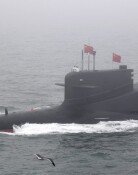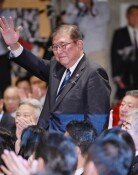Unified C4I System Crucial: Expert
In 2012, when the Combined Forces Command structure is dissolved, a different command and control system between the ROK and the U.S. armies is likely to complicate Command Control Communication Computer Intelligence (C4I) and make it ineffective.
Professor Bruce Bechtol of the U.S. Marine Corps Command and Staff College emphasized on November 25 that the superiority of C4I and air power is the most decisive war deterrent that the current combined forces have.
Bechtol, one of the leading experts on the Korean peninsula among U.S. military experts, said that his remark is not reflecting the policies of the U.S. government or universities, but is mainly based on his personal opinion. But he pointed out the problems of the ROK-U.S. military alliance and the military command system issue between the ROK and the U.S. (as covered by Dong-A Ilbo on page A1-3 on November 24).
Dong-A Ilbo: Many people are saying that the Korean army should establish C4I capability independently for the sake of self-reliance of national defense.
The self-reliance of national defense is a lofty and expensive goal. South Korea is confronting North Korea, the worlds fifth largest military power. The Korean army has to upgrade its C4I and air power significantly in order to reach the level of defense capacity the U.S. army is maintaining in the Korean peninsula.
Emphasizing that the Korean army should pay more attention to sensor to shooter capacity, Professor Bechtol took the example of C4I system recently built in the armys Fifth Corps and the Koreasat Mugunghwa. The Defense Ministry announced that they established a ground C4I system in the Fifth Corps linking corps, division, regiment and battalion HQs this June for the first time in the history of the Korean army.
However, it is hard to say that that was a true operation of C4I. That is not connected to the national system. That is just C3 (Command Control Communication), which will support the Korean armys capability for a couple of years, but not C4I. C4I is an integrated system which connects sensed information to commanders in battles.
Professor Bechtol said, The current Korean army is entirely dependent on the U.S. for strategic information. The Korean side said that the U.S. would continue to provide C4I capability even after the dissolution of the Combined Forces Command, but I wonder how they would obtain sensor to shooter capability at the combined forces command level during war, even without an integrated command center.
Dong-A Ilbo: Are there any other expected strategic problems due to the dissolution of the Combined forces Command?
First, there are three to four problems. For example, the Korean army has elite airborne troop and a Marine Corps, but there arent enough transport planes and amphibious warships to deploy them all. Also, air power should rely on the U.S. army even more than before. And the Korean army has no method to intercept the Norths missiles. The South tried to buy PAC-2 interceptors system from Germany, but they may not work against all of the Norths scud missiles. In the end, the Korean army should depend on the US armys PAC-3 missile defense system.
He added, The U.S. should provide enough bridging capability until a switch in the ROK-U.S. military alliance is completely made, and he also pointed out that, The problem is once the Combined forces Command is dissolved, the provision of bridging capability would be more difficult to make.
Military force has a longer-term agenda than politics. An opponent would decide on a threat based on two elements, military strength and intention. Therefore, those in charge of Koreas defense should prepare under the assumption that the North could attack the South if South Koreas war deterrent weakens.
sechepa@donga.com






